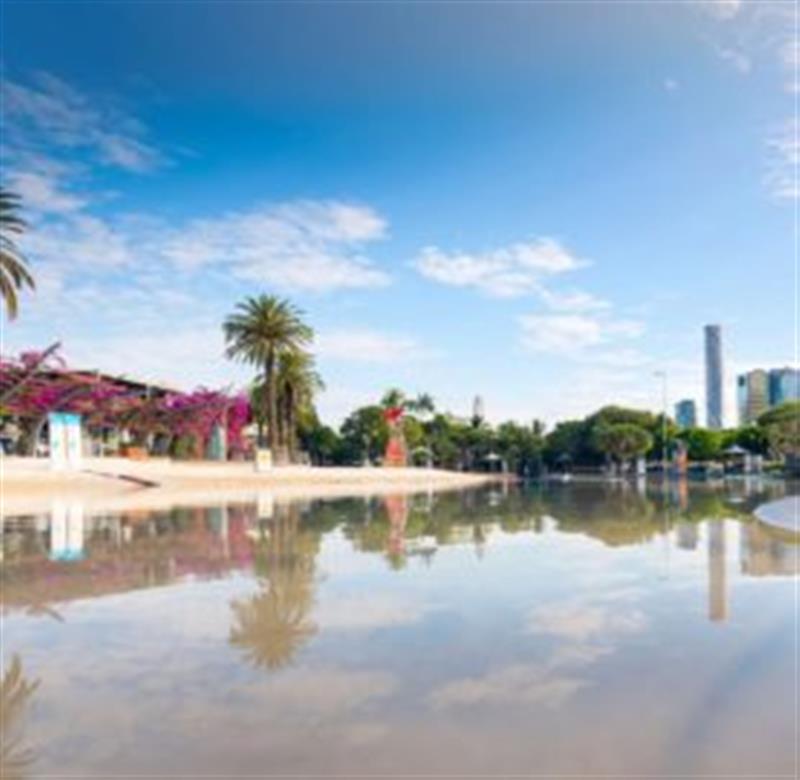
The South Bank Parklands, as they are today, were opened to the public on 20 June 1992 followed by 16 days of festivities. Discover South Bank, the former site of World Expo 88, and home to a myriad of historical points of interest. Take off on your own to discover the sights and rich history, or join a South Bank Greeters Tour, where a knowledgeable local will guide you through the Parklands.
For ease of navigation, this trail begins at the southern end of the Parklands. It’s time to get your exploring hats on!
Queensland Maritime Museum
412 Vulture St, South Brisbane
The Maritime Museum was founded in 1971 and contains a two-level exhibition building presenting historic sailing ship models, together with merchant shipping from early cargo ships to modern container ships, tankers and cruise liners. It is housed in the building used for the “Pavilion of Promise” at World Expo 88. The museum was given permission to occupy the site of the dry dock in 1973 and was opened to the public in 1979.
South Brisbane Dry Dock
412 Vulture St, South Brisbane
The South Brisbane Dry Dock was built in the 1870s and is one of the last remaining vestiges of the establishment of the colony of Queensland. For the first 70 years of settlement (1820s to 1890s) the people of Queensland were almost entirely dependent on maritime transport for the movement of freight and passengers. The dry dock closed in 1972.
Ship Inn
Stanley St & Sidon St, South Brisbane
The New Bowen Hotel, which is now known as the Ship Inn, was first opened in 1866. It boasted “commanding views of Government House, the Botanical Gardens, the river, and the city”. After closing down in 1979, it reopened just prior to Expo 88. The Ship Inn was heritage-listed for nine years, before being taken off the Queensland Heritage Register in 1993 due to it being “altered to such a degree that its heritage value had been lost”.
Clem Jones Promenade
Clem Jones Promenade was named in recognition of a former Lord Mayor of Brisbane, Clem Jones AO, who provided the vision and direction to acquire South Bank riverside land on behalf of the people of Brisbane.
Epicurious Garden
The ornamental and productive Epicurious Garden in the heart of the South Bank Parklands is designed to educate and inspire the home gardener. Visitors will have the opportunity to learn how to cook with home-grown produce and a variety of herbs.
The Arbour
Lined with bright pink bougainvillea, the Arbour is a hard one to miss. It is about 1km long and contains over 400 plants.
Stanley Street Plaza
Here you will find the Plough Inn and Allgas Building. There has been a hotel on the site since the early 1860s. The Plough Inn was rebuilt in the 1880s during South Brisbane’s economic boom. The Allgas Building was constructed in 1885 as the business premises of drapers, Allan and Stark. Known as Allgas House since its days as Expo 88’s bank, the building now houses offices and is the former site of the South Bank Visitor Information Centre.
Expo Sculptures, Human Factor Series
About 175 works of sculpture were either commissioned, purchased or borrowed for World Expo 88. Some of these are still in existence today. Keep an eye out for the white figures created by artist and designer John Underwood. They aimed to unify the Expo 88 site and create a constant in the ever-changing streetscape of entertainers.
Streets Beach
Take a leisurely dip at Streets Beach. It’s the size of five Olympic swimming pools and is the only “beach” to be found in the middle of a city in Australia.
Rainforest Walk, Liana Lounge and Rain Bank
As you walk through the Rainforest Walk, keep your eyes peeled as you may spot some wildlife such as water dragons and the controversial bird, the ibis. The Liana Lounge was inspired by Australia’s native liana vines, which you can see throughout the Rainforest Walk. See the Rain Bank’s recycling centre in action at the viewing deck. It can harvest up to 77 million mega litres of water each year!
Nepalese Peace Pagoda
The Nepalese Peace Pagoda is one of several buildings from Expo 88 still located at South Bank today, and is the last remaining international exhibit. It showcased wood carving as a traditional Nepalese craft and took 160 Nepalese village families over two years to build.
Victoria Bridge Abutment
The stone abutment is a remnant of the steel bridge opened in 1897 after the original 1874 steel bridge was destroyed by the 1893 floods.
Cultural Centre
The Queensland Cultural Centre consists of the Performing Arts Centre, the Art Gallery, State Library, Museum and the Gallery of Modern Art (GOMA). The first stage of the precinct, the Art Gallery, was completed in 1982.
South Brisbane Railway Station
This commanding railway station building was constructed in 1891. Its design was an expression of South Brisbane’s prominence in this era.
William Jolly Bridge
When first opened in 1932, the William Jolly Bridge was known as the Grey Street Bridge and was built in response to the escalating traffic volumes across the Victoria Bridge.
To find out more and to book a South Bank Greeters Tour, contact the South Bank Visitor Information and Bookings Centre on (07) 3156 6366 or vicsouthbank@brisbanemarketing.com.au. Greets begin 10am daily from the centre. Maximum six people per tour. Bookings are essential and must be booked 24 hours in advance.